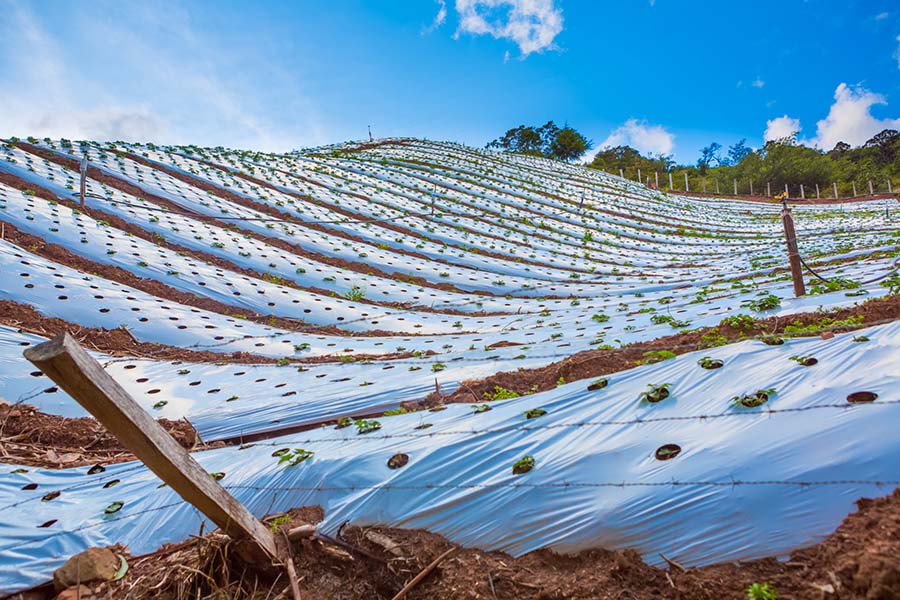Setting the Stage for an Effective Installation
The success of a slit film woven geotextile installation hinges on the groundwork. Rushing through initial steps like site assessment and preparation can leave you with an installation that doesn’t work effectively and doesn’t last as long as needed.
Fortunately, a site assessment doesn’t have to be complicated. Start by taking a close look at your land’s topography: Are there slopes? How steep are they? Slopes affect water runoff, fabric stability, and anchoring strategy. Also, consider soil type—sandy, clay, loam—as this impacts drainage under the fabric and how it might settle. Next, check the existing weed situation. What weeds are present, especially tough perennials, and how dense are they? This information will determine how much pre-cleaning is needed. Finally, walk the area to identify and note any debris: rocks, sharp sticks, old roots, or anything that could damage the fabric or make for an uneven lay.
With a good assessment done, preparation focuses on creating a clean, smooth base:
Clear all debris
Remove every stone, branch, and sharp object you find. You’ve probably already planned to do this to prepare the area for planting — go around one more time for a more detailed clear to prevent damage to your ground cloth.
Eliminate existing weeds
You need a completely clean surface for a clean start. Depending on your system and philosophy, you might opt for targeted herbicide use (with proper waiting periods), shallow cultivation some weeks prior to allow for a final weed-out, or other methods suitable for your operation. The goal is no live weeds under the fabric.
Level and smooth the ground
A smooth, even surface ensures the fabric makes good contact with the soil. It minimizes air pockets, which could allow weeds to gain a foothold if light and moisture somehow get in. Direct soil contact helps water move predictably over or through the material. For beds, this step includes final shaping and crowning.
Consider soil testing
Preparing the ground is an opportune time for routine soil tests to guide your fertility program for the upcoming crop.
Attentive site preparation will quickly pay off with simplified installation and maintenance, better performance, and a longer, more effective lifespan.
Choosing the Right Slit Film Product
Not all slit film woven geotextiles are created equal, and selecting a product that matches your needs and site conditions will help you achieve top results and a good return on your investment. Your site assessment will help guide your choice. When evaluating your options, consider these primary specifications:
Fabric Weight (oz/SY or GSM)
This tells you the fabric’s weight per unit of area. In the United States, this is commonly expressed in ounces per square yard (oz/SY). In metric system countries or on many technical datasheets, you’ll see grams per square meter (GSM). Both measure the material’s density and give a good indication of its general robustness.
Heavier Weight Fabrics (approximately 3.5 oz/SY / 118 GSM and higher)
These fabrics are generally thicker, stronger, and more durable. For instance, BTL Liners’ slit film product specified at 4.0 oz/SY (about 136 GSM) falls into this robust category. Heavier weights typically offer better resistance to tearing and punctures (from rocks, aggressive weeds, or foot/light machinery traffic) and are suited for a longer lifespan.
Consider a heavier fabric for long-term installations (like orchards or permanent beds), areas with high weed pressure (especially tough perennials), or where the fabric will experience more physical wear.
Lighter Weight Fabrics (around 2.0 - 3.0 oz/SY / 68 - 102 GSM)
These are more lightweight and can be less expensive. They might be suitable for shorter-term applications, sites with lower weed pressure, or where easier handling of very large sections is a priority and maximum durability isn’t the primary concern.
MARV
When looking at fabric weight, you might also encounter the term MARV (Minimum Average Roll Value). If a weight is specified as “MARV” (e.g., 4.0 oz/SY MARV), it’s a quality assurance term. It means the average weight from any tested roll of that product is guaranteed to meet or exceed that stated value and ensures a reliable minimum standard. Always balance your durability requirements with budget and handling practicalities.
UV (Ultraviolet) Stabilization
Polypropylene, the material commonly used for these geotextiles, degrades when exposed to sunlight over time. UV stabilization is a treatment added during manufacturing to protect the fabric from this degradation.
Importance
Good UV stabilization is critical for the fabric to last in any agricultural use where it is exposed to the sun (which is most uses). Without it, the material will become brittle, tear easily, and lose weed-blocking effectiveness sooner than expected.
What to Look For
Check manufacturer specifications for information on UV resistance, often indicated by an expected lifespan under typical sunlight exposure (e.g., “5-year UV rating, 10-year lifespan”). A higher level of UV stabilization generally means a longer service life. Don’t skimp on this feature for exposed applications.
Roll Size (Width and Length)
This is a practical matter that affects installation efficiency and material use. Slit film woven geotextiles come in various widths (e.g., from 3 feet up to 15 feet or more) and lengths (often several hundred feet per roll). Choose roll widths that best match your row spacing or bed dimensions to minimize cutting, waste, and the number of seams or overlaps needed. Fewer seams generally mean fewer potential weak points for weed emergence if overlaps aren’t perfect. Larger rolls cover ground faster but are heavier to handle. Plan based on your equipment and labor.
Other Factors
Other factors like fabric color (black for maximum weed control and soil warming, or white for soil cooling, depending on your crop and climate) and ensuring the product specifies good water and air permeability (a key feature of slit films) also play a role. Always review product data sheets and discuss your needs with reputable suppliers to make an informed choice.




